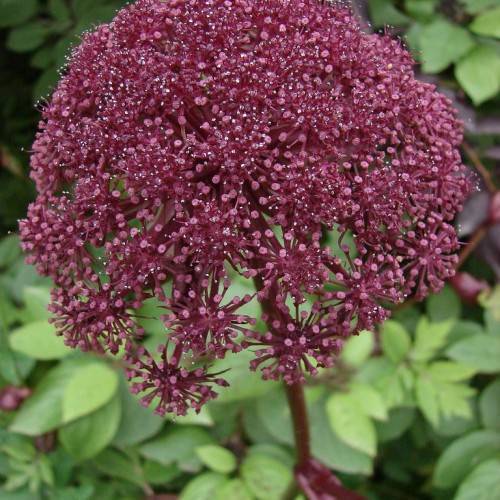
giant angelica
Angelica gigas
Cycle:
Herbaceous Perennial
Watering:
Frequent
Hardiness Zone:
4
Flowers:
Flowers In Summer
Sun:
Full sun only if soil kept moist, Part sun/part shade
Soil:
Acidic, Humus rich
Cones:
Yes
Leaf:
Yes
Growth Rate:
Moderate
Drought Tolerant:
Yes
Salt Tolerant:
Yes
Invasive:
Yes
Care Level:
High
watering
Giant angelica (Angelica gigas) should be watered thoroughly about every 10 days. As a general rule, check the soil near the base of the plant with a finger to determine if the plant needs water. If the soil feels dry, it is time to water the plant. When watering, make sure to water the entire root system- at least 12-15 inches down - to ensure moisture is reaching all parts of the root system. Avoid overwatering, as it can lead to root rot.
sunlight
Giant angelica (Angelica gigas) should ideally receive full sunlight for at least 6 to 8 hours per day. In order to do this, the plant should be placed in a sunny location that gets direct sunlight in the early morning and late afternoon hours. If grown indoors, the plant should be placed in a window with southern or western exposure. During the summer months, the plant will benefit from full sunlight all day long, but it is important to be careful about too much direct sunlight, as it may lead to sunburn or other damage to the leaves. Additionally, the plant should not be kept in direct sunlight for extended periods of time in the hottest part of the day (generally noon to 4 PM).
pruning
Giant angelica (Angelica gigas) should be pruned from early summer to early fall, when the majority of the blooms on the plant have faded and the leaves are beginning to senesce. The stems of the plant should be pruned to approximately 12-15 inches in height once blooming has ended. The plant should also be regularly thinned out during the season to encourage new growth and to reduce the density of the existing growth. Furthermore, deadheading should be done as blooms fade to ensure other blooms are able to form and reach their full potential. If necessary, light pruning can be done during the winter to remove any dead or diseased growth.
